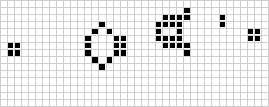Digital Truth: Emergent Origins pt.1
 Tuesday, October 4, 2011 at 10:11AM
Tuesday, October 4, 2011 at 10:11AM Jonathan Blow never fails to inspire me. If not to design video games better, at the very least he gets me to write articles like this. To me, Blow's GDC talks tend to illustrate the obvious in the most delicate and elegant ways. From the design of Braid, previews of The Witness, his GDC talk topics, and his entire presentational style, Blow seems to exude elegance because his understanding is so clear and simple. Seeing no need to clutter his message with reiteration, watch Jonathan Blow's talk "Truth in Games" before continuing.
Abstraction, emergence, and understanding. These three topics are at the core of Blow's talk and this article. We'll investigate the curious relationship between these three ideas to reveal something true about game design and the universe.
Abstraction

Years ago I begun my exploration of the critical concepts and language necessary to thoroughly discuss game design. The first article series for this purpose focused on the core of the interactive medium that is video games. It is titled "Mechanics and Abstractions." Back then I had a bias for what I called "concrete mechanics." What I couldn't express at the time is that "abstract mechanics," the opposite of concrete mechanics, can cause a variety of unwanted effects to the end user experience. The basic idea behind my thought process is that the more mechanics (gameplay actions) are designed around common, relatable, or real world actions the stronger a foundation the game can build off of. Put another way, the more abstract the design of a mechanic, the more the creator arbitrarily changes the interactions. This leads to gameplay where players have to learn the designer's particular point of view which may or may not mesh well with other design choices.
After years of writing, I no longer have this bias. However a designer decides to design their game is fine by me. Instead of worrying about an isolated decision, it's more effective to focus on how the decision works for or against the whole. Arbitrary and abstract mechanics can be just as well designed and interesting as concrete mechanics. Furthermore, it makes little sense to categorize mechanics by their abstractness because everything in a video game is an abstraction. Like with books or paintings, nothing about the representations are real even if they seem so. The words on the page are just symbols. The images on the screen are just color pixel data matched with sound. And the interactions in a video games are simply code made to look and feel like interactions we're familiar with. Since everything in a video game is created, it's all an abstraction on some level. Or so I thought. Jonathan Blow has proposed another idea.
Math is similar to and yet unlike verbal languages in a way that's perfect for this topic. Like words, numbers, operators, and equations can describe the world. But unlike words, numbers can be translated, multiplied, and applied to a changing scenarios. Using graphs and charts we can fully encapsulate phenomena of our real world. F = ma is more than just an equation. It's a way of understanding the unique relationship between force, mass, and acceleration. We can use this formula to calculate how much force we have when we're running on the track. But when we put this equation into our games and it works to calculate force for game objects, where's the abstraction in that? As long as the relationship between force, mass, and acceleration is preserved, is the game abstracting the real world or recreating it in a direct way?
"Where did all this indescribable complexity come form. It didn't come from this equation. It wasn't put into the video by the author of the video. There are no slots in this equation for what we in the game industry call content. What we're seeing is something about the structure of the universe. It's may be one small corner of the universe, but that's what we're seeing." J.Blow
Emergence
 A Gosper Glider Gun. More on emergence here.
A Gosper Glider Gun. More on emergence here.
Blow thinks digital code can embody truth in the universe. It's hard for people to see how math and programming code work because, I think, math can be quite simple, objective, and abstract. This is not to mention how many have developed a disdain and fear of math. So, I don't think it's much of a stretch to say that most people can't appreciate math equations for their elegance, explanatory power, and all of the possibilities they govern. Not many can look at an equation and visualize a graph and extrapolate what that graph means. Even when the calculations aren't too complicated, we're just not wired to think this way.
It's the same way with emergence in video games. When I think about a new mechanic or system change for a game like Super Mario Bros, my mind explodes envisioning all the divergent and emergent possibilities. I can see scenarios in my mind and understand fully what rules caused them to happen. I can weigh player expectation and behavior and manipulate the variables like a emergent conductor. Now, I'm starting to realize that people generally don't think this way. People don't see the possibilities or the potential. They don't understand all the switches and levers at work. Needless to day, visualizing possibilities in one's head is very difficult. And even those who are good at it are still limited by fairly limited mental capacities.
"There is more to a system than can be understood just by reading its rules."
"It may be beyond human understanding not because it's complicated... but because it's so simple. It's so basic. It is so much like fundamental things that we just don't have very much experience with that it is [that it's] hard for us to grasp." J. Blow
Understanding

To put it as clearly as I can, the universe is a system. It has rules (laws) that govern the way everything operates, works, and functions. These rules are at the core, which give rise to many varied and complex things. Though all of these infinitely varied results and possibilities are complex, the core is something very simple; so simple it can be hard for us to understand. These core rules or truths can be represented directly in digital simulations. Blow claims that a tendencies for designers is to create games around these cores, but then muddle the purity, effectiveness, and elegance of the core by adding in designer arbitrations. In other words, adding rules and interactions to the game system just because. While this isn't necessarily a bad thing, for those who want to tap into the profound simplicity of the core truths of the universe, the best way to do so is to push aside your preconceived aims for your creation, and to pay close attention to what truth is already in your system. By designing games this way, we're more likely to present some truth of the universe which everyone should be able to relate to universally, rather than just our biased, culturally constructed, limited, views.
How do we come to understand the truths of the universe, emergence, and abstractions of it? As Blow put it, we use systems to answer questions. Knowing that the system operates under a set of rules (hopefully consistent rules) we manipulate the input, analyze the output, and come to know the nature and truth of the system through this process. That's a fancy way of saying we use trial-and-error. We do this with real life and with video games. This is how we use systems to answer questions even if the questions/systems are complex or difficult to articulate.
Of course it helps when the output is such that we can perceive and appreciate what's happening in the system. A spreadsheets and a graph can contain the same data points, yet a graph may be far more appreciable to more people. This is what Blow means when he talked about making emergence "appreciable to the senses." Feedback and form are clearly important parts of the way we learn and use systems. This is why clean game design is so important. For a designer like me who understands emergence and can see how the interrelated parts of a system produce results and effect the user, I put a great importance on clean game design.
In part 2 we'll look at emergent gameplay examples and player behavior to trace the game design features that make them possible.

